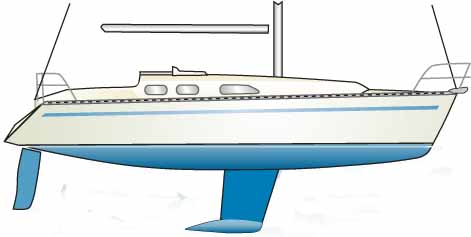Theoretical Insights into Hull Speed
The hull speed of a sailboat represents a theoretical maximum speed achievable by displacement vessels, fundamentally guided by their waterline length. Understanding how to calculate it can significantly impact a sailor’s expectations regarding boat performance and overall sailing experience.
How to Calculate Hull Speed
To determine hull speed, one can apply a straightforward formula: take the square root of the boat’s waterline length measured in feet and multiply that figure by 1.34. For instance, a sailboat with a waterline length of 25 feet would have a hull speed of approximately 6.7 knots (about 7.7 mph). This mathematical concept stems from the foundational work of British engineer William Froude, who identified the inherent relationship between a boat’s velocity and its design characteristics.
Table of Hull Speeds
| Waterline Length (Feet) | Max Hull Speed (Knots) |
| 20 | 6.0 |
| 25 | 6.7 |
| 30 | 7.3 |
| 35 | 7.9 |
| 40 | 8.5 |
| 45 | 9.0 |
| 50 | 9.5 |
Resistance Types and Their Impact
During a sailboat’s journey, it faces several types of resistance, primarily categorized into frictional resistance and wave-making resistance.
- Frictional Resistance: This resistance arises from the water’s interaction with the boat’s hull, effectively increasing drag. A maintained and clean hull minimizes friction and enhances speed.
- Wave-Making Resistance: As a vessel speeds through water, it generates waves. When reaching hull speed, the boat can get stuck in a ‘wave train,’ making further acceleration a challenge without additional power.
Is Hull Speed a Hard Limit?
The figure of 1.34 may act as a guiding principle, primarily for conventional heavy-displacement hulls. Nonetheless, modern designs, such as planing hulls, redefine what’s possible.
- Planing Hulls: These vessels, commonly found in racing yachts, are capable of lifting above their bow waves with sufficient sail power, allowing them to exceed theoretical hull speeds.
- Multihulls: Catamarans and trimarans, with their slender shapes, avoid the hull speed trap, producing minimal wave-making resistance, thus faster speeds compared to monohulls of similar length.
Factors Influencing Speed Beyond Hull Length
While the hull length is pivotal, several additional elements affect the overall performance of a sailing vessel:
- Displacement: A lighter hull offers reduced resistance, allowing for greater speeds.
- Wetted Surface Area: The hull’s underwater area will create friction; thus, minimizing contact can enhance performance.
- Hull Shape: Fine and streamlined shapes reduce wave-making resistance, improving efficiency.
- Balanced Keel and Rudder: Proper alignment ensures effective steering while minimizing drag, leading to better speed.
Propeller Drag and Speed Performance
For sailboats equipped with auxiliary engines, the propeller can introduce significant drag. This “propeller drag” is particularly troublesome for performance-focused vessels. To combat this, sailors can opt for:
- Folding Propellers: These blades retract when not in use, reducing drag.
- Feathering Propellers: Featuring blades that pivot for reduced resistance, they enhance performance when sailing.
Understanding Heel’s Role
When a monohull sails, its heeling can alter the effective waterline length. In certain racing designs, this phenomenon might even contribute to increased speed by virtue of changing dynamics.
Practical Considerations: Sea Conditions
Calculations of hull speed often assume calm, flat waters. In reality, a vessel’s speed through water can greatly fluctuate due to external factors.
The Impact of Sea State
Waves can either hinder or facilitate sailing speed. A sailboat struggling against a head sea experiences increased resistance, while one riding with following seas may achieve higher speeds through the aid of wave energy.
Speed Through the Water vs. Speed Over Ground
While knotmeters indicate speed through the water (STW), GPS devices measure speed over ground (SOG). Being aware of currents is crucial, as favorable currents can enhance SOG, while opposing currents can diminish it.
As GetBoat, we’re always on the lookout for developments that affect sailing and seaside vacations. Understanding the mechanics of hull speed not only enlightens boat enthusiasts but also plays a crucial role in planning for enjoyable leisure experiences on the water. Our platform offers an array of options to rent or charter sailboats of various styles, tailored to individual preferences and budgets. Whether seeking an adventure alone or with companions, choosing the right vessel is key to experiencing the freedom of the open water.
The journey of discovering a new location by sailboat transcends mere navigation; it encapsulates immersion into local culture and breathtaking scenery, akin to enjoying local cuisine or architecture. When planning your next sea escapade, consider the classes of sailboats available for rent. Each inlet and bay offers unique narratives shaped by both the sea and the culture, and must be explored through direct experience. Don’t miss out on discovering these and more through GetBoat.com.
Заключні думки
The world of sailing is vast and deeply intertwined with technical aspects like hull speed, resistance, and design. By understanding these factors, sailors can optimize their experiences, ensuring efficient and thrilling voyages. Preparing a boat expedition reflects a rich tapestry of exploration that harmonizes with the elegance of nature, the thrill of adventure, and the delighted anticipation of water activities. With resources like GetBoat.com, venturing into the marine realm is simplified, allowing sailors to unlock unforgettable experiences on their journeys.

 Unraveling Sailboat Hull Speed and Its Calculation">
Unraveling Sailboat Hull Speed and Its Calculation">
